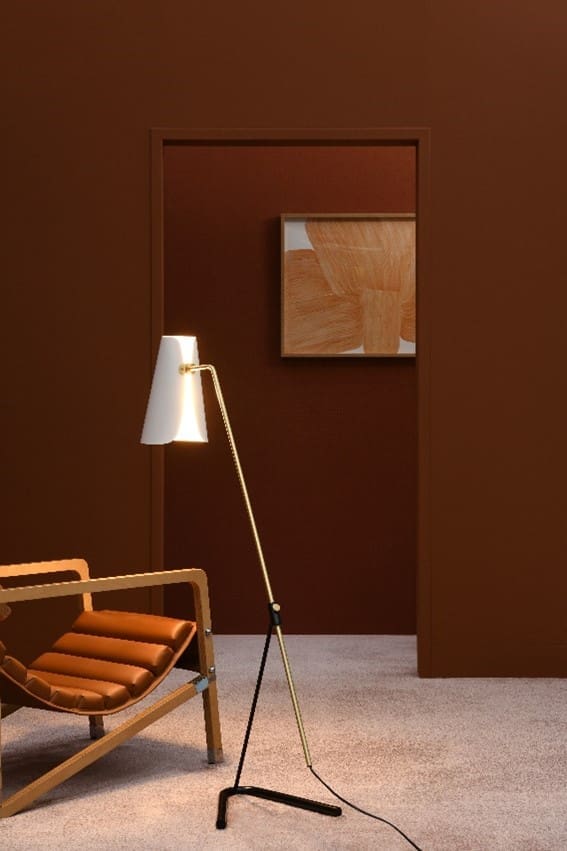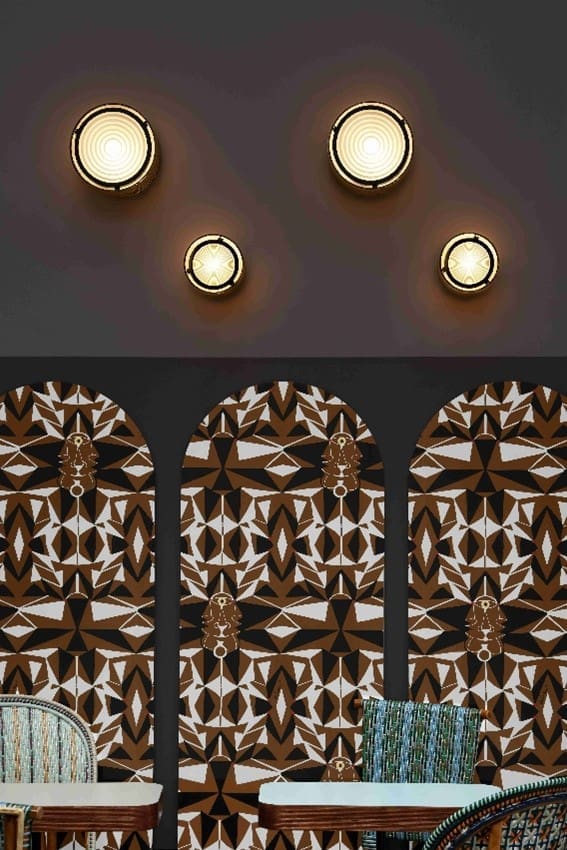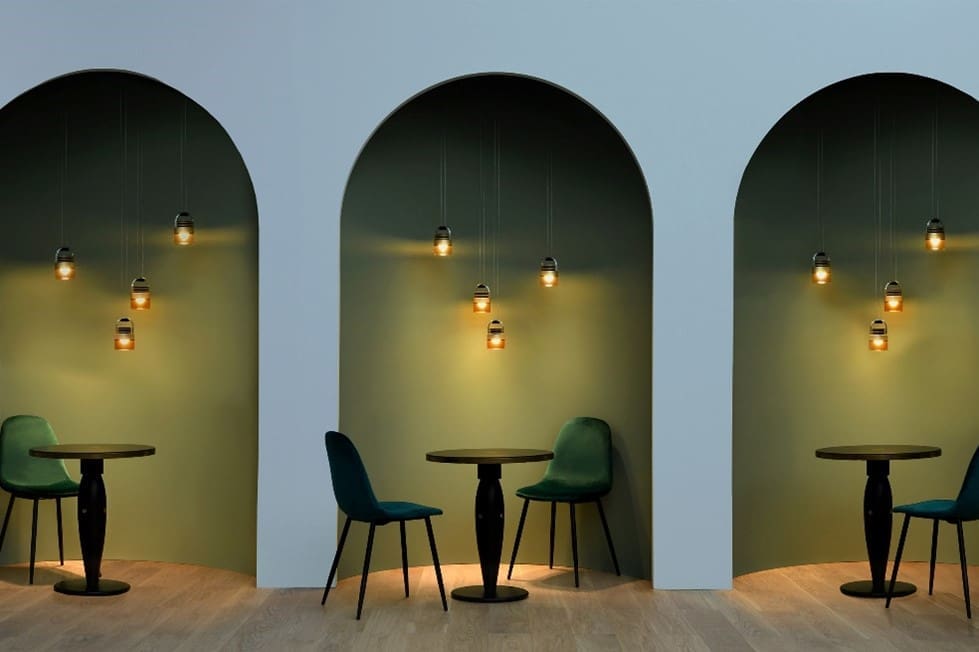Work Café : Which lighting suits New Work concepts?
If you want to design office space according to the principles of New Work, then you will most likely also integrate a Work Café. Or a lounge area for informal encounters and meetings, where people like to meet for a coffee to brainstorm, but where there is still a cheerful, working atmosphere. The aim is to create a flexible, collaborative working environment that reflects the New Work culture. And it's not just workplaces that need to be properly lit; lighting can also make a valuable contribution in the Work Café, as it influences the atmosphere in the room, has a direct impact on people's well-being and thus on the way the space is used.
What is pleasant lighting for a relaxed working environment?
Several important aspects should be taken into account for the lighting in work cafés. Unlike an office workplace, a cosy atmosphere should prevail here. On the one hand, this can invite collaboration and, on the other hand, it can also serve as a place to retreat and work on something in peace. Of course, it makes sense to create an area in the work café where colleagues or team members can socialise. And a quiet area where mobile phones are switched off and there are well-insulated individual chairs so that you can work in peace.
To create the right lighting mood, lighting planner Jörg Drewes recommends the following:
Modelling the room depth with light colours
The use of warm colour temperatures, preferably around 2700K, creates cosiness and cocooning. This colour temperature should mainly be used where people sit down and make themselves comfortable, i.e. around tables and armchairs.
Perhaps you have also planned a counter where people can get a delicious espresso or latte macchiato directly from the barista. You can attract attention there with slightly colder light colours and brighter light.
Create contrasts and set accents
High-contrast lighting with light and dark areas and the use of accents contribute to the atmosphere and avoid monotonous light. It is therefore a good idea to install indirect luminaires on the walls. This illuminates the faces of the people present more favourably. Above the tables, pendant luminaires can provide direct lighting for the work surface so that any drawings and notes can be clearly seen. Light can also be used to emphasise various decorative elements with targeted lighting, creating accents. And in between, there are always areas that are less illuminated, making the contrasts in the room visible. Just like in nature, where there is usually light and shade.
Conscious use of daylight
If natural light is available, you should of course make use of it. But be careful, daylight can also be dazzling! For this reason, the course of the sun should be taken into account when planning and, if necessary, screens or blinds should be placed in front of the windows so that direct sunlight can be regulated, at least in summer.
Work Café Lighting made concrete
Between heritage design …
In an inviting work café, you should create a symbiosis of functionality and cosiness. Warm, calming colours contribute to a relaxed atmosphere that invites you to linger. The eye falls on an elegant armchair in Heritage design, which is flooded with the soft lighting of a G21 floor lamp - a masterpiece by Pierre Guariche.
The warm rays of the lamp invite you to make yourself comfortable in the armchair, laptop on your knees, and spin creative thoughts in peace and quiet.


… and tribal art
Contrasts were deliberately emphasised in this room concept as part of New Work. Different styles become a new whole, emphasised by the sophisticated lighting of the G13 luminaires by Pierre Guariche. Elegantly mounted in black on the wall above the tables, these luminaires create an inviting environment that skilfully sets lighting accents.
The glare-free lighting of the G13 luminaires not only creates a pleasant brightness, but also subtly emphasises the creative freedom that the interior designer has chosen in this room. The simple elegance of the luminaires harmonises perfectly with the creative atmosphere created by the room's bold design decisions.
The lights are not only functional, but also aesthetically pleasing and help to create an inviting and inspiring aura in the room


Lighting for cosy New Work concepts
Working atmosphere in the coffee house…
In this innovative concept, the interior designer has created small alcoves that house the tables and create almost private spaces. Here you can meet with colleagues and work undisturbed in a cosy atmosphere.
The elegant MOD AIR pendant luminaires by Stefan Diez hover above the tables, illuminating not only the table but also the laptop with targeted light. These luminaires are not just light sources, but genuine design elements that characterise the ambience of the café.
The MOD AIR luminaires not only provide targeted lighting accents, but also create glare-free illumination thanks to baffles and soft, diffuse glass cylinders. This creates a pleasant working atmosphere that promotes concentration and at the same time creates an inviting atmosphere.

…or like at home
An oasis of productivity and relaxation is revealed here. The MOD wall lights by Stefan Diez create artistic accents on the wall, while a comfortable armchair and an elegant side table are invitingly waiting to be discovered. Here, style and comfort merge into a harmonious unit that is perfect for cosy working.
In this cosy ambience, the targeted lighting from the wall lights creates an atmosphere that is both inspiring and calming. The armchair invites you to sit down, take out your laptop and immerse yourself in your work, while in the background the aroma of a freshly made cappuccino from the in-house café bar tantalises the senses.
This oasis of well-being is more than just a workplace - it is a retreat that combines the best of aesthetics and functionality. Here you can not only work productively, but also enjoy life's little pleasures to the full.


FAQ
Does the light colour change the perception of colour?
Yes, light colour influences colour perception, but not colour rendering, which is often measured by the so-called colour rendering index (CRI). The CRI indicates how accurately a light source reproduces colours compared to natural sunlight. It is rated on a scale from 0 to 100, with higher values meaning better colour rendering. Lights with a high colour rendering index can clearly distinguish between colours that may be very similar. This is why this is particularly important in creative or medical professions.
What do I need to look out for with glare-free lighting?
Light sources should be positioned so that they do not shine directly into the user's eyes. Indirect lighting or directing the light towards ceilings and walls can help to minimise direct glare. Above all, care should be taken to ensure that the light sources are not aimed directly at the laptop, which may be placed on the café table, to prevent glare from reflections. Diffuse light is also gentler on the eyes and helps to reduce glare. Integrated diffusers or covers over the light sources help to avoid harsh shadows.
Of course, there are also glare-free luminaires that are specially designed to avoid glare and are equipped with darklight louvres, for example. However, these lights tend to be reserved for office workstations.
Not only artificial light can be dazzling, natural light sources can also have a disturbing effect. Therefore, when planning the lighting in rooms with natural light (windows), blinds or curtains should be included where necessary to regulate the daylight.
Can lighting increase well-being?
Yes, natural light, especially in the morning, contributes to the regulation of the circadian rhythm, which influences the sleep-wake cycle. Good lighting during the day can improve sleep and boost energy levels. This is why light colour and light intensity are so important. The closer a lighting system is to natural daylight, the more positive the effect, as the right light can have a positive influence on mood and emotions. Warm light is often perceived as cosy and calming, while cool light can have a stimulating effect. Working environments with intensive lighting and a cold light colour promote productivity and concentration. An appropriate level of lighting that avoids glare enables people to perform their tasks more effectively.
Other interesting articles on the subject of lighting and New Work:
- Room psychology and light: planning and lighting New Work workplaces correctly
- The right lighting in the workplace: light changes spaces, space changes work
- REPLAY - Webinar Light + Space: Planning and illuminating informal meeting rooms

